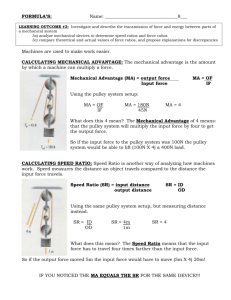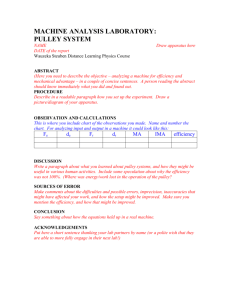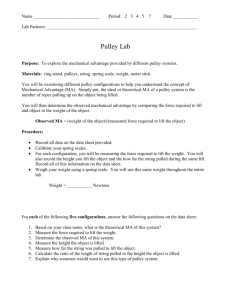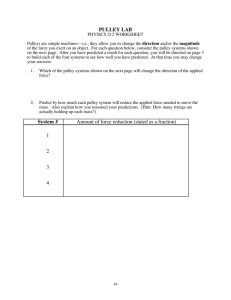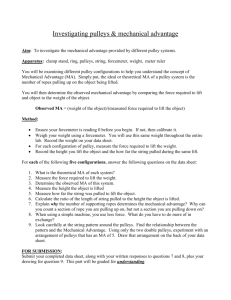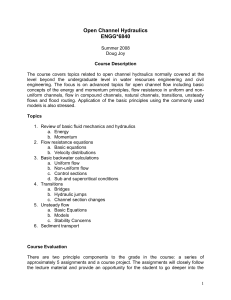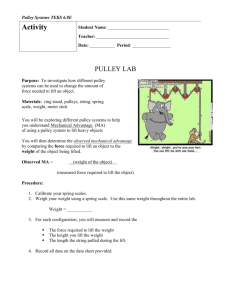formulas
advertisement
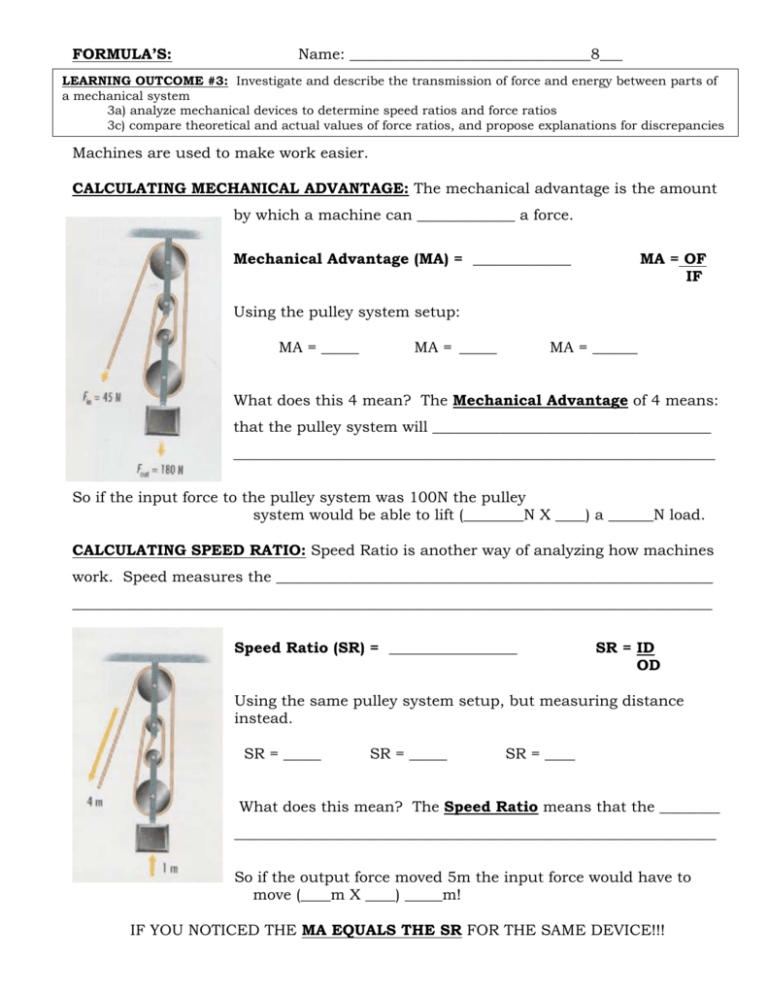
FORMULA’S: Name: ________________________________8___ LEARNING OUTCOME #3: Investigate and describe the transmission of force and energy between parts of a mechanical system 3a) analyze mechanical devices to determine speed ratios and force ratios 3c) compare theoretical and actual values of force ratios, and propose explanations for discrepancies Machines are used to make work easier. CALCULATING MECHANICAL ADVANTAGE: The mechanical advantage is the amount by which a machine can _____________ a force. Mechanical Advantage (MA) = _____________ MA = OF IF Using the pulley system setup: MA = _____ MA = _____ MA = ______ What does this 4 mean? The Mechanical Advantage of 4 means: that the pulley system will _____________________________________ ________________________________________________________________ So if the input force to the pulley system was 100N the pulley system would be able to lift (________N X ____) a ______N load. CALCULATING SPEED RATIO: Speed Ratio is another way of analyzing how machines work. Speed measures the __________________________________________________________ _____________________________________________________________________________________ Speed Ratio (SR) = _________________ SR = ID OD Using the same pulley system setup, but measuring distance instead. SR = _____ SR = _____ SR = ____ What does this mean? The Speed Ratio means that the ________ ________________________________________________________________ So if the output force moved 5m the input force would have to move (____m X ____) _____m! IF YOU NOTICED THE MA EQUALS THE SR FOR THE SAME DEVICE!!! Calculate the following Mechanical Advantage and Speed Ratio for each device used! MECHANICAL ADVANTAGE SPEED RATIO 1 Calculate the mechanical advantage This mechanical device has an input when it takes 200N to move a 550N distance of 45m and an output distance of object. 15m. 2 Hans made a tree branch trimming machine to help clean up his yard. The input effort to the machine was 2.7N but the output was 6N. Hans’s tree branch trimming machine needs to be moved 0.5m to cut a distance of 0.2m. 3 Robert invented a machine that would do his work for him. His machine used 5.6N and produced 11N. Robert’s machine moves 2.3m when the input force moves 5m. 4 Arnold built a machine to help deliver the morning paper. He had to pull with 38N of force to move a stack of papers that had a force of 92N. Arnold’s machine moves the load 1.8m when the input distance is 6.2m. Does the MA = SR for the above devices? _______ What do you think accounts for the difference? So Mechanical Advantage will always be __________________ than Speed Ratio! 5. Can the mechanical advantage of a device be less than one? pg 282 Think of a bicycle. It has a mechanical advantage of less than one! Why do we use them then? 6. Mechanical Advantage is always LESS THAN Speed Ratio because Mechanical Advantage is affected by _____________________. Mechanical Advantage is more realistic than Speed Ratio. 7. We now want to look at the EFFICIENCY of the device. EFFICIENCY means: the measurement of how well a machine uses the input energy. Efficiency is measured as a percentage! EFFICIENCY = _________________________________ Eff = MA SR X 100 8. Calculate the efficiency of the machines in questions 1-4 (formula, substitute in, answer with units) #1 Eff = MA X 100 Eff = _____ X 100 SR Hans Robert Arnold 9. THE MORE ENERGY THAT IS LOST BY A MACHINE DUE TO FRICTION ( AS __________) THE LESS EFFICIENT IT IS! Less input energy converted to output energy! 10. Can a machine be 100% efficient? Explain. 2.2 The Science of WORK!! Page 287 1. Work is done: when a __________________ acts on an object to make it _____________. If the object DOES NOT MOVE—no work is done! WORK = ____________(N) x _______________(m) Units for WORK: N·m W=Fd (1N·m = 1 JOULE) 2. If you used 50N to lift a chair 0.4m, what is the amount of work done? W=Fd W= ____N x ____m W= ____N·m or ____Joules 3. You used a force of 40N to push a box of books 3.2m. How much work has been done? 4. A pulley uses 1000N to lift a piano up 10m. How much work is being done? 5. a. Calculate the amount of work needed to lift the box up onto the loading dock (known as WORK OUTPUT). 800N 2m b. Calculate the amount of work needed to push the box up onto the loading dock using the incline plane. (known as WORK INPUT) c. Is there any difference in the amount of work done in (a) and (b) to get the box to the top of the loading dock? Yes or No In either case the WORK INPUT = WORK OUTPUT d. Why would pushing the box up the loading dock seem easier? FORMULA CALCULATIONS: FORMATIVE ASSESSMENT Name: ____________________________ 8___ Date: ________________ LEARNING OUTCOME #3: Investigate and describe the transmission of force and energy between parts of a mechanical system 3a) analyze mechanical devices to determine speed ratios and force ratios 3c) compare theoretical and actual values of force ratios, and propose explanations for discrepancies 3d) identify work input and work output in joules for a simple machine or mechanical system a. Place the following data onto the simple machine diagram. -input force: 70N -output force: 200N -input distance: 30m -output distance: 10m b. This simple machine is called a ____________________________ and the advantage you would get is __________________________________. c. Calculate mechanical advantage. d. Calculate the speed ratio. e. Why is the speed ratio and mechanical advantage different? f. Calculate the efficiency for this simple machine. g. Why is this machine not 100% efficient? h. Calculate the work done by this simple machine. Be careful on what data you use! Beginning demonstrates limited academic achievement shows an incomplete understanding of the learning Acceptable Proficient demonstrates basic academic achievement shows an adequate understanding and simplistic application of the learning demonstrates strong academic achievement shows a solid understanding and relevant application of the learning Mastery demonstrates exemplary academic achievement shows an in-depth understanding and insightful application of the learning in a variety of situations 2.3 Hydraulics Page 293 We have already looked at hydraulics in the Mix and Flow unit. Remember that hydraulics lift/move very large loads. A hydraulic system uses _______________ under ___________________ to move loads. The hydraulics _______________ the mechanical advantage of levers. Before hydraulics were invented, construction projects were mainly done by _____________, using ______________ __________________ (inclined planes, _______________, _____________ and ____________) P = F/A P = _________________ F = _______________ A = ________________ Pascal’s Law: pressure applied to an enclosed fluid is transmitted __________________ in _______ _______________ throughout the fluid. Hydraulics use a fluid such as ___________ Pneumatics use a fluid such as ___________ Calculate the mechanical advantage of the hydraulic below. 20N 500N FORMULAS: W=Fd Eff = MA X 100 SR SR = ID OD MA = OF IF
